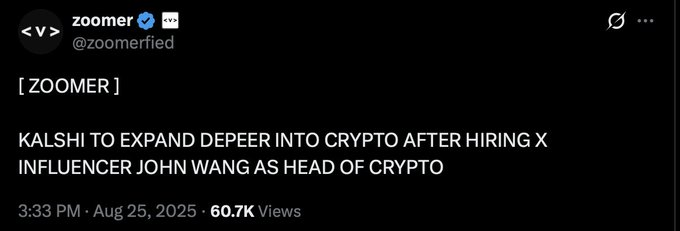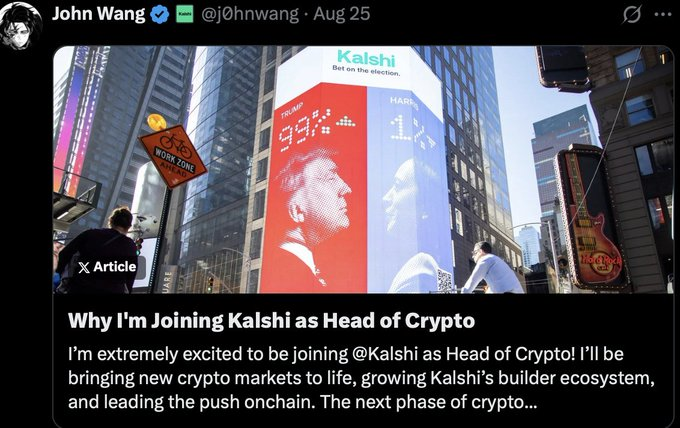Author: TM
Compiled by: Tim, PANews
I probably shouldn't publish this article because it's too incisive. Let's dive deep into the world of crypto marketing: a masterclass in psychological tactics.
If you don't know what psychological tactics mean? It means your entire adult life has been manipulated.
Welcome to the world of Meme wars.

Milady
Example 1: Kalshi's Entry into the Crypto Market
Let's start with Kalshi. This isn't about spreading FUD; in fact, I admire their execution. I'm just sharing personal thoughts on events related to Kalshi, and of course, what is said here is unverified.
As the Meme coin craze fades, prediction markets are starting to gain attention. Some KOLs have begun to push this narrative, including John Wang.
There’s no doubt that prediction markets are fairer than Meme coins. Meme coins are a brutal 1 to 1000 game, while prediction markets at least balance the odds. But to be honest: the fanatics in the crypto market just love tokens, and that’s always been the case.
So the question becomes: how to capture market share from Meme coins without issuing new coins, while challenging top platforms like Polymarket?
The answer: psychological warfare
Here's how it went down:
- John Wang signed with Kalshi long before the official announcement.
- In the months prior, social interactions and researcher citations boosted the attention on his account.
- When the news was finally released, the promotional campaign was coordinated: news media, influencers, and "research" pages all reported the same KOL's hiring news.
 News reports about hiring a cryptocurrency KOL
News reports about hiring a cryptocurrency KOL
This was shaped into a major event, as if Kalshi had just poached an executive from Google or Apple.
A simple yet clever psychological tactic: turning personnel changes into a full-scale marketing campaign.
Kalshi is not just entering the crypto space; they are making it look like a paradigm shift.
They spent money hiring these websites, research institutions, and influencers to discuss this announcement. A personnel change that caused a stir. Kalshi officially enters the crypto market, with momentum comparable to a FAANG stock IPO.
A simple but effective psychological tactic: they released an announcement and turned it into a large marketing campaign.

Is John Wang the marketing manager of Kalshi?
Example 2: ai16z Flywheel
Now, let's talk about ai16z.
This idea is genius. It made people (including myself) genuinely look forward to the future of Crypto x AI.
The script goes like this:
- They launched a Meme DAO around the idea of tokenizing the venture capital giant a16z.
- Marc Andreessen himself responded, validating the meme's viral value.
- Suddenly, the entire industry’s attention was focused on this "new AI fund."
- Then came the product launch: Eliza AI Agent.
It quickly shot to the top on GitHub. The timing was perfect, and the hype was unstoppable.

Shaw showing off
But at its core, it’s just a GPT wrapper. To put it bluntly, it connects the API of existing large language models to the front end, nothing groundbreaking.
Who cares? In fact, no one cares. The product is useful, the atmosphere is right, and that’s enough.
The psychological tactic here is not just about technology; it’s about narrative.
Joining the ai16z DAO has become a status symbol. Just like wearing a Rolex watch in the early days, being an "ai16z partner" means you are now part of the inner circle, attracting developers from top universities and wealthy believers.
The DAO's market cap soared to $2.5 billion (but with laughably low liquidity). The flywheel effect was thus formed: hype attracts liquidity, liquidity attracts investors, and investors generate more hype.
But then the question arose: how to cash out without ruining the chart?
The answer: you don’t need to. Instead, ai16z "sells" their technology to other crypto AI projects in exchange for up to 10% token allocation agreements, gaining marketing support in the process.
The result? A flood of half-baked AI projects. Support, pump, dump.

Shaw after selling off free crypto AI tokens
The psychological tactic worked. Liquidity was drained, and now ai16z is planning a comeback.
The Essence of Psychological Tactics
The problem is: the same trick can't succeed twice.
Once people see through this ruse, it loses its market. The public will turn to chase the next shiny thing. That’s why many projects keep recycling those old buzzwords:
- Airdrop
- Roadmap
- Buyback
- Flywheel
- Economic model
If you hear these, the project is merely in its early stages. In this market, empty talk is outdated; delivering products is the hard truth.
Welcome to the Meme Wars
Today's crypto marketing is not advertising; it's war.
Narrative is the weapon, interaction is the ammunition. Every announcement, every collaboration or controversy is a battle for mental share.
Winning projects are not just selling technology; they are executing a coordinated psychological warfare: weaving stories, memes, and strategies that the target audience is willing to believe.
Not everyone plays by the same rules.
So if you want to capture market share in this industry, you better arm yourself. Assemble your team like a Roman general preparing for conquest.
Because in the crypto space, it’s a war.
免责声明:本文章仅代表作者个人观点,不代表本平台的立场和观点。本文章仅供信息分享,不构成对任何人的任何投资建议。用户与作者之间的任何争议,与本平台无关。如网页中刊载的文章或图片涉及侵权,请提供相关的权利证明和身份证明发送邮件到support@aicoin.com,本平台相关工作人员将会进行核查。




